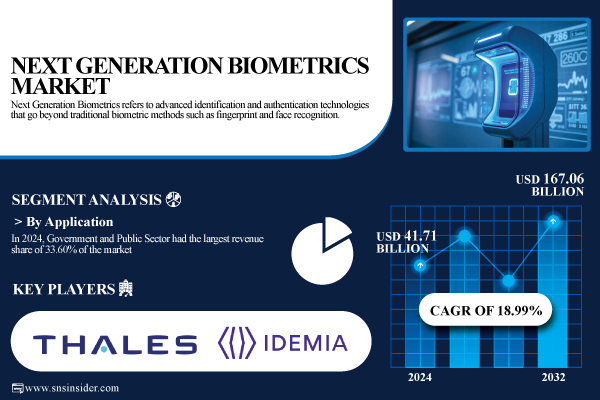
The global Next Generation Biometrics Market is projected to reach a staggering USD 167.06 billion by 2032, expanding from a valuation of USD 41.71 billion in 2024. This growth is anticipated at a compound annual growth rate (CAGR) of 18.99% from 2025 to 2032, according to a report by SNS Insider. The surge in demand for enhanced security measures across various sectors—including government, banking, and consumer markets—fuels this upward trend.
The increasing need for secure and contactless authentication methods is a key driver behind the robust growth in the biometrics industry. Innovations in biometric technology and initiatives aimed at digital identity are further accelerating adoption. Notably, biometric systems are estimated to reduce identity fraud by over 50% compared to traditional identification methods.
In the United States, the biometrics market is set to reach USD 37.36 billion by 2032. This growth is driven by government mandates focusing on national security, border control implementations, and early adoption within the banking and healthcare sectors. The widespread integration of biometrics in consumer devices is evident, with approximately 65% of fintech applications now providing biometric login options, prompting advancements in embedded sensors and corresponding software.
Key Market Segments and Trends
The Next Generation Biometrics Market showcases a variety of biometric technologies, with fingerprint recognition currently commanding a substantial 34.20% market share in 2024. This technology is prevalent in mobile devices, government identification programs, ATMs, and access control systems, owing to its reliability and cost-effectiveness. Meanwhile, facial recognition technology is anticipated to exhibit the highest growth rate, with a projected CAGR of 20.21% through 2032. Its appeal lies in contactless, rapid verification processes applicable in areas such as surveillance, airports, and public safety.
In terms of application, the government and public sector led the market in 2024, accounting for 33.60% of total revenue. This segment is driven by extensive deployments in national security, law enforcement, and civil administration. The National ID Programs segment is expected to expand the fastest, achieving a CAGR of 20.59% as countries in Asia, Africa, and Latin America increasingly adopt digital identity initiatives to streamline citizen services.
By deployment model, on-premise solutions accounted for 24.60% of the market in 2024, favored in secure environments such as government and defense sectors. In contrast, cloud-based deployments are expected to grow at the highest rate, with a projected CAGR of 21.95% through 2032, as organizations seek scalable and cost-effective solutions.
Regional Insights and Future Outlook
North America currently leads the global Next Generation Biometrics Market, capturing 31.80% of revenue in 2024. This dominance is supported by strong governmental investment in homeland security, border control projects, and increasing adoption across various industries, including banking and healthcare. The Asia Pacific region is anticipated to experience the fastest growth, with a CAGR of 19.92%, driven by digital transformation initiatives and high mobile penetration rates in countries such as India and China.
Europe remains a significant player in the biometrics market, with a focus on secure identity verification and compliance with regulations such as GDPR. Germany is particularly notable for its advancements in border control and digital identity initiatives. Other regions, including the Middle East and Africa, spearheaded by the UAE, as well as Latin America, led by Brazil, are also leveraging biometric technology for immigration, banking, and smart city projects.
The insights provided by this report highlight the dynamic nature of the Next Generation Biometrics Market and its potential for continued growth driven by technological advancements and increasing demand for secure solutions across multiple sectors. As organizations seek to enhance security and streamline processes, the adoption of biometric technologies is poised to accelerate in the coming years.






